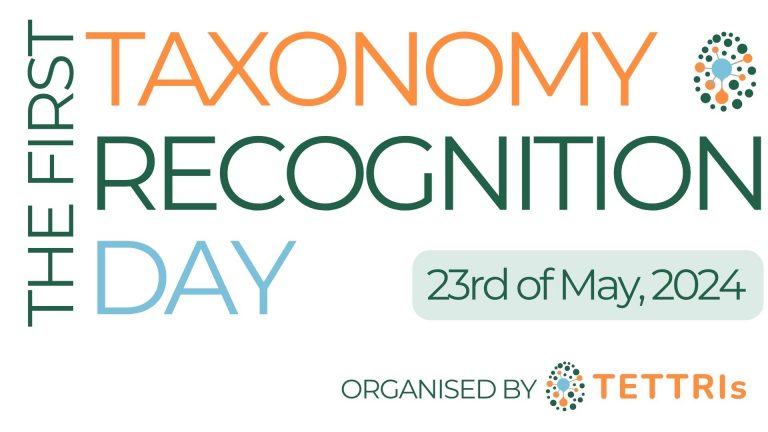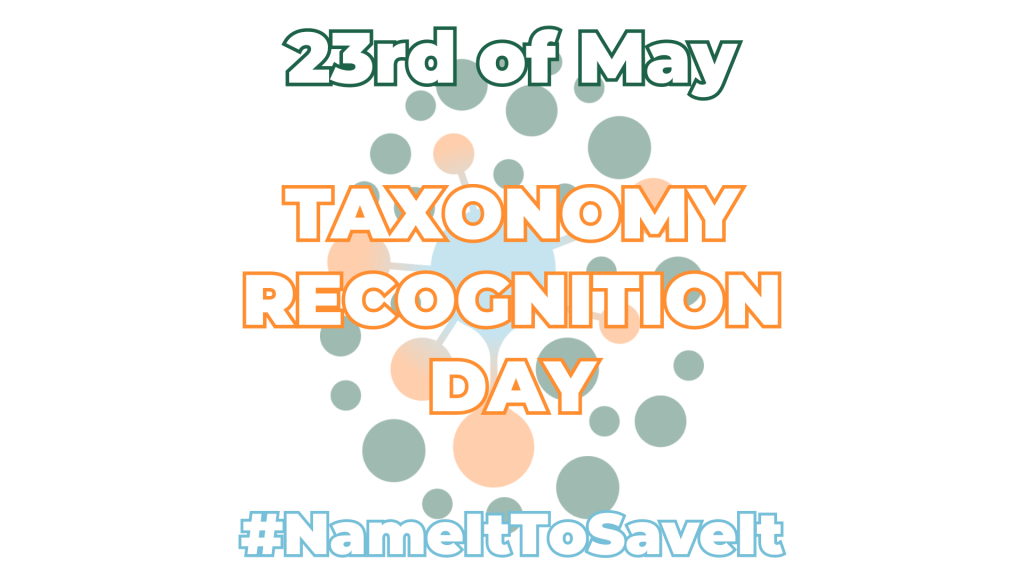
On May 23rd, 2024, TETTRIs will launch the inaugural Taxonomy Recognition Day.
The event, organized by a Europe-wide consortium of Natural History Museums, research institutes and taxonomic facilities, marks a milestone in advancing the recognition and appreciation of taxonomy’s critical role in preserving global biodiversity.
Researchers at the Natural History Museum of Vienna, Martin Kapun and Ines Méhu-Blantar have compiled a literature list articulating the necessity of taxonomic research:
· “Taxonomy is the basis for communicating about organisms1 and is fundamental to the field of biology.”2
· “The primary goal is not to name species but to understand them.”3
· “Taxonomy goes beyond discovering and naming new species. It is driven by evolutionary hypotheses which help to create predictive classifications and improve our understanding of biotic diversity through meticulous systematic revisions and homology assessments.”3
· “Frequently, taxonomy is mistaken for mere identification, which is comparable to confusing diagnosing an illness with conducting medical research.”4
· “If there are no skilled taxonomists left who truly understand the subject, publications might discuss applied or other aspects of plants. However, if the plants are incorrectly named, it becomes unclear which species the findings refer to.”5
· “If taxonomy continues to be relegated to the archives, a situation will soon arise where such misidentifications as mentioned above are the norm, rather than the exception, for there will be no one left who knows the species and can identify them properly. Nor can anyone referee the incoming papers properly due to the dearth of detailed and accurate taxonomic know-how.”5
· “Involving the public at large in the taxonomic enterprise may indeed be productive (see also Fontaine et al., 2012a; Wheeler et al., 2012), but contributes no more to taxonomic progress in the broad sense than identifying trees or butterflies through a mobile phone app.”3
· “Despite recognizing the valuable contributions of competent self-taught taxonomists, the advancement and quality of taxonomy primarily depend on sustained educational efforts supported by robust theoretical, epistemological and philosophical frameworks.”3
· “Globally, alpha-taxonomy articles represent less than 1% of the WoS-indexed literature, with a modest annual growth rate of 5.14% observed from 2008 to 2012.”

Relevant examples (text from the referenced papers):
Misidentification of vectors can lead to wrong decisions during Malaria control
The malaria vector system in Southeast Asia is complex because of the number of species potentially involved in malaria transmission. What was thought to be an unusual morphotype of An. minimus was shown to be Anopheles varuna, and most specimens identified as the former species in the field proved to be the latter species. Very few An. minimus individuals were found during the study period. Because this species was previously being misidentified as An. minimus, a nonvector was mistargeted as a malaria vector in Binh Thuan Province6
Misidentification can lead to worthless research
Many obvious misidentifications have resulted in more than a few papers worthless to science published in high impact factor Indian journals. These studies often concern results of applied biological subjects such as ecology, biodiversity, cytology, morphology, anatomy, phyto-chemistry, ayurvedic pharmacognosy, ethnobotany, experimental biology, etc., but are based on serious and often obvious misidentifications5
Misidentification can lead to wrong protection plans
Spatial records of species are commonly misidentified, which can change the predicted distribution of a species obtained from a species distribution model. Species misidentification errors may act to contract or expand the predicted distribution of a species while shifting the predicted distribution towards that of the contaminating species7
Medically important model species could be misidentified or misinterpreted, as in the case of the medicinal leech.
Accurate annotation of bioactive compounds relies on precise species determination. It has been shown with mitochondrial sequences and nuclear microsatellites, that there are at least three species of European medicinal leech, and that leeches marketed as H. medicinalis are actually Hirudo verbana.8,9
Misidentification and mislabeling can lead to wrong medication of snake bite intoxication
Snake bite envenoming, mainly caused by the saw-scaled or carpet viper (Echis ocellatus), is a neglected disease of West Africa. However, some dangerously inappropriate products of Indian origin are being marketed by unscrupulous manufacturers or distributors in Africa and Papua New Guinea, with disastrous results. A major source of confusion is labelling antivenom with ambiguous snake names that fail to distinguish the Asian species whose venoms are used in their production from the local snakes whose venoms are antigenically dissimilar.10
Taxonomy may have different effects on conservation efforts
We found that changes in taxonomy do not have consistent and predictable impacts on conservation. Nevertheless, there are some general trends: (i) All of the examples where taxonomic change helped protection involve splitting (e.g., Chiricahua leopard frog, Ozark spring beauty, Sorbus). (ii) Taxonomic change has least impact on the protection of iconic or charismatic organisms, protected areas of special status, and economically important groups. And finally (iii), taxonomic progress can be detrimental to conservation when it involves species amalgamation (lumping) or reveals the hybrid nature of a species.1
Taxonomy to identify new potential human pathogens and disease vectors
As part of a prospective study of leptospirosis and biodiversity of Leptospira bacteria in the Peruvian Amazon, a new Leptospira species was isolated from humans with acute febrile illness. Field trapping identified this leptospire in peridomestic rats (Rattus norvegicus, six isolates; R. rattus, two isolates) obtained in urban, peri-urban, and rural areas of the Iquitos region. Novelty of this species was proven by serological typing, 16S ribosomal RNA gene sequencing, pulsed-field gel electrophoresis, and DNA-DNA hybridization analysis11
Two new mosquito species (Diptera: Culicidae), Culex (Melanoconion) phyllados n. sp. and Culex (Melanoconion) brachiatus n. sp. from the state of Amazonas, Brazil, are here validated and described based on morphological features of the male genitalia.12
Taxonomy to identify new potential crop species13
A new Coffea species from Cameroon is described and compared with the other species of Central Africa. Coffea charrieriana Stoff. & F. Anthony can be recognized easily using morphological characters of leaves, flowers and fruits. Moreover, it is the first record of a caffeine-free Coffea species for Central Africa and only the second report for the African continent.14
A new species of Dioscorea (edible yams) from Morondava prefecture in Western Madagascar is described. Dioscorea bako is a favoured food source for people of the Menabe region and is reported by them to be increasingly hard to find. Immediate conservation measures are necessary to ensure that it remains extant and, in the medium to long term, research should be undertaken to guide its sustainable utilisation.15
Taxonomy to inform viral disease control16
Here, we first provide an overview of the latest research progress in the classification of the Nidovirales order and then introduce the host range, genetic variation, genomic pattern and pathogenic features of epidemic CoVs and other epidemic viruses. This information will promote understanding of the phylogenetic relationship and infectious transmission of various pathogenic nidoviruses, including epidemic CoVs, which will benefit virological research and viral disease control.

References
1. Morrison, W. R. et al. The impact of taxonomic change on conservation: Does it kill, can it save, or is it just irrelevant? Biological Conservation 142, 3201–3206 (2009).
2. Costello, M. J., May, R. M. & Stork, N. E. Can We Name Earth’s Species Before They Go Extinct? Science 339, 413–416 (2013).
3. de Carvalho, M. R. et al. Does counting species count as taxonomy? On misrepresenting systematics, yet again. Cladistics 30, 322–329 (2014).
4. Löbl, I., Klausnitzer, B., Hartmann, M. & Krell, F.-T. The Silent Extinction of Species and Taxonomists—An Appeal to Science Policymakers and Legislators. Diversity 15, 1053 (2023).
5. Kholia, B. S. & Fraser-Jenkins, C. R. Misidentification makes scientific publications worthless – save our taxonomy and taxonomists. CURRENT SCIENCE 100, (2011).
6. Bortel, W. V. et al. Confirmation of Anopheles varuna in vietnam, previously misidentified and mistargeted as the malaria vector Anopheles minimus. The American Journal of Tropical Medicine and Hygiene 65, 729–732 (2001).
7. Costa, H., Foody, G. M., Jiménez, S. & Silva, L. Impacts of Species Misidentification on Species Distribution Modeling with Presence-Only Data. ISPRS International Journal of Geo-Information 4, 2496–2518 (2015).
8. Siddall, M. E., Trontelj, P., Utevsky, S. Y., Nkamany, M. & Macdonald, K. S. Diverse molecular data demonstrate that commercially available medicinal leeches are not Hirudo medicinalis. Proceedings of the Royal Society B: Biological Sciences 274, 1481–1487 (2007).
9. Utevsky, S. Y. & Trontelj, P. A new species of the medicinal leech (Oligochaeta, Hirudinida, Hirudo) from Transcaucasia and an identification key for the genus Hirudo. Parasitol Res 98, 61–66 (2005).
10. Warrell, D. A. Unscrupulous marketing of snake bite antivenoms in Africa and Papua New Guinea: choosing the right product—‘What’s in a name?’ Transactions of The Royal Society of Tropical Medicine and Hygiene 102, 397–399 (2008).
11. Matthias, M. A. et al. Human Leptospirosis Caused by a New, Antigenically Unique Leptospira Associated with a Rattus Species Reservoir in the Peruvian Amazon. PLoS Negl Trop Dis 2, e213 (2008).
12. Hutchings, R. S. G. & Sallum, M. A. M. <strong>Two new species of <em>Culex</em> subgenus <em>Melanoconion</em> (Diptera: Culicidae) from the Amazon forest</strong>. Zootaxa 1920, 41–50 (2008).
13. Grieneisen, M. L., Zhan, Y., Potter, D. & Zhang, M. Biodiversity, Taxonomic Infrastructure, International Collaboration, and New Species Discovery. BioScience 64, 322–332 (2014).
14. STOFFELEN, P., NOIROT, M., COUTURON, E. & ANTHONY, F. A new caffeine-free coffee from Cameroon. Botanical Journal of the Linnean Society 158, 67–72 (2008).
15. Wilkin, P. et al. An Endangered New Species of Edible Yam (Dioscorea, Dioscoreaceae) from Western Madagascar and Its Conservation. Kew Bulletin 63, 113–120 (2008).
16. Zhou, Z., Qiu, Y. & Ge, X. The taxonomy, host range and pathogenicity of coronaviruses and other viruses in the Nidovirales order. Animal Diseases 1, 5 (2021).

